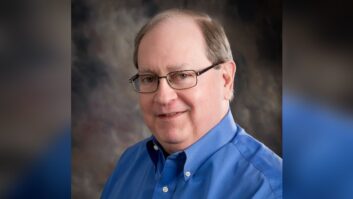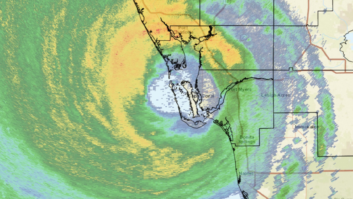Working separately working together
Aug 1, 2005 12:00 PM, By Chriss Scherer, editor
WAOR–one of two studios on the ground floor–is adjacent to the sales area, making them accessible to station visitors as a showcase view.
Lots of stations need lots of signals. The backyard is the site of several satellite antennas and an STL tower.
The B-100 studio is a mirror image of the WAOR studio next door.
WYPW is automated most of the day, so an Auditronics console was used in the studio. A DJ setup is used for a daily mix show (below).
The two production studios serve as back-up air studios.
Greg Trobridge checks the processing in the rack room, which is a showcase in itself with its clean layout and aesthetic lighting.
The showcase studio in Elkhart faces the street corner from the ground floor, which gives the stations a close tie to the community.
Any facility construction project starts with establishing the needs of the stations that will use the facility. In most cases, it is a straight-forward process to identify the station’s needs and temper them with the owner’s goals. Joint sales agreements and local marketing agreements with a second licensee can be a factor in the plans, but what happens when you have four licensees and two distinct locations? The Federated Media stations in South Bend and Elkhart, IN, have figured it out.
With studios in two adjacent counties, the seven stations are split into two studio facilities. WAOR-FM (95.3, classic rock), WBYT-FM (100.7, country), WYPW-FM (95.7, CHR/urban), WNIL-AM (1290, news/talk), WRBR-FM (103.9, active rock) and WUBU-FM (106.3, smooth jazz) share a studio building in Mishawaka, a town near South Bend. WLEG-AM (102.7, adult contemporary) and WTRC-AM (1340, news/talk) share space in Elkhart. While all the stations serve a smaller market � Arbitron ranks South Bend as market 177 � the studios are built as well as any major-market facility.
The interesting twist is that Federated Media is not the sole licensee of the stations in the South Bend facility. The five stations are licensed to four owners. Federated Media owns WBYT and WAOR. Second Wind Communications owns WRBR and has a joint sales agreement with Federated Media. Talking Stick Communications owns WYPW and operates under an LMA with Federated Media. Partnership Radio owns WUBU and contracts operations functions from Federated Media.
The South Bend stations all operate under the Planet Radio name, which serves to provide a unifying brand to the listeners, but still maintains the necessary separation of business elements between the licensees.
For all of this, there is a single engineering staff of two people: Chief Engineer Greg Trobridge and Assistant Engineer Jeff Snyder. They are employees of Federated Media, and through the licensee agreements they handle the technical needs of the other stations as contracted engineers. While the facility is fully integrated so that common resources are shared, there are times when Trobridge has to work with four general managers or program directors to see a project to completion.
The plans for the Planet
The Planet Radio stations occupy a two-story facility that was remodeled at the end of 2004. Federated Media already occupied the second floor, so when the first-floor tenant moved out, it seized the opportunity to consolidate all the stations under one roof. Two studios (WBYT and WAOR) are on the ground floor. While all the studios are well designed and look good, these two are used as the showcase studios for visitors because of their easy access.
The first floor also houses the engineering shop, sales offices, business offices and programming offices for the first-floor stations. The second floor houses the remaining studios, programming staffs for those stations, the tech center and the station managers.
The heart of each station’s operation is a Harris Airwave Digital console in all but one studio and a Broadcast Electronics Audiovault automation system. The first-floor studios are mirror images of each other because they were built at the same time. The remaining studios have similar layouts, but each is unique.
Some common design elements can be seen in the studio photos. These include a truss mounted along the ceiling to support the speakers and the LED signs. Driven by Sine Systems MBC-1 sign controllers, each air studio displays two LED signs, while the production studios have one. Each studio has one sign for general information such as ringing phones and after-hour visitors. The second sign in the air studios displays EAS information and notifies the operators when a station is off the air.
The air studios also have a KVM switch for the second computer to switch the monitor between the Audiovault system and the general use (Internet) computer. This allows the cohost to view the on-screen program log. While the video switches, the cohost does not have mouse or keyboard control of the on-air system to avoid confusion.
Every studio can be used to create voice tracking for the station. To reduce the possibility of errors by switching the console, a Henry Engineering Stereo Mixer was installed to mix audio for the automation system for the song ending, the song starting and the mic. This removes the console from the voice-track chain, and it sets a fixed level on the music. This prevents the voice tracking person from adjusting the audio level in his headphones, a change that will not be made on the air later.
The Audiovault keyboard and mouse are wireless units, which eliminates cord tangles. Because the keyboard is not needed often, this has proven to be a smart choice because the keyboard is usually needed when a problem arises, which is exactly when the cord is likely to be wrapped around something.
The audio and control trunk cables are terminated on Homaco wiring racks on each end. These hold the punch blocks on one frame that is easier to mount than individual block mounts.
Moving up
The second floor houses the remaining studios. While the first floor was completely remodeled when the previous tenant left, this space did not see the same construction, but the spaces were updated as needed.
The production studios are similar to the first-floor studios because they were built about the same time. WUBU is automated and can use the production studios to go live.
The WYPW studio is in one of the existing studios from before the rebuild. This station is also automated most of the time, and when it is live, the programming is usually a music mix show. A club DJ setup is installed on the backside of the on-air console. Because the on-air console does not see much use, an Auditronics 210 was refurbished and put into use.
The last studio built was for WRBR. While the other rebuilt studios use Harris Quick-built furniture, this studio has furniture from Woodline Furniture, a manufacturer based in Michigan. The furniture was designed to look similar to the Quick-built furniture.
The second floor also houses the tech center for the facility. The 10 racks hold all the behind-the-scenes equipment, but this space is far from being simply a practical space. The racks are lit with an overhead spotlight system that makes for an impressive view. Unfortunately, space did not allow for the rack room to be showcased through a glass wall. The station is located next to a power substation, so commercial power reliability is not normally a problem. When it does fail, the proximity to the substation means that the station’s power is restored quickly. As a backup, the broadcast operations have a UPS to power everything needed to remain on the air as well as the office telephone system and computer network. Office PCs have their own UPS systems as they are needed.
Down the street
The two stations in Elkhart have strong ties to the community. Talk station WTRC particularly wanted to reinforce its importance to the listeners, so a corner showcase studio on the street was designed when its studios were rebuilt. This studio has several TV monitors to display various news channels, which fits with the station’s news/talk format.
This studio is set up with three uses in mind. The console position, at the center of the furniture, is at stand-up height and looks into the corner of the studio toward the street. To the right of this position is a cohost position, which is a few steps from the studio door. This allows the cohost, who is usually a news reporter, to quickly enter the studio and deliver his newscast.
The area to the left of the operator is set up for sit-down interviews. This allows the host to be in a comfortable position with his guests and still have a clear view to the operator and to the outside windows.
The furniture, custom-made by Harris, was designed with open space below to keep the open feel and to eliminate a hard furniture barrier between the station air staff and the listeners watching on the street. The studio also has a high ceiling � about 11 feet � which adds to the open feel.
A talk show with multiple guests requires many mics, and if all the mics are open at once, acoustic problems are likely to occur. In addition, the console has a limited number of inputs. Because of this, an automatic mic mixer, the Shure SCM810, is used. This system automatically mutes mics that are not being used, which improves the audio quality.
It’s through this effective use of the available technology that the engineering staff is able to serve the needs of the stations and the separate owners. Because of this cooperation, these Northern Indiana stations have found a way to serve their collective audiences better.
Managing the data
All the stations run RBDS and are ready to provide PSD when they begin transmitting IBOC. When RBDS was implemented a few years ago, Trobridge was not satisfied with the performance of the available data management systems and interfaces, which were unable to provide the flexibility that the stations wanted, or required an ongoing licensing fee that the stations were not willing to pay.
Instead, Trobridge built the system that he wanted. A custom-written application takes the PSD information from the station automation systems to feed the RBDS encoders. The software allows the station program director to update text fields and provide additional information that can be displayed.
The software provides station promotional messages when commercials are played so that song information is not showing when commercials are playing. The promotional messages are day-part scheduled on a programmed clock.
It provides data to feed the now playing portion of the stations’ websites. The software is written to feed Audemat-Aztec, Inovonics and Terion RBDS encoders, and it can provide scrolling PS if it is wanted. In addition, it can display warning messages that are manually entered or triggered by EAS.
The software also has an adjustable delay that accounts for the nine-second profanity delay that is used on all the stations.
Partial Equipment List
360 Systems Shortcut
Adobe Audition 1.5
Air Tools 6000, 6100
Aircorp 500
AKG C3000B
Aphex Compellor
ART SLA2 and SLA1 power amps
Audemat-Aztec FMB-80
Audio-Technica AT4033
Auralex acoustic panels
Belden 1189A RG-6
Bogen TP30D tuners
Broadcast Electronics Audio Vault AV-100
Broadcast Tools SM II, SS16
Burk ARC-16, Autopilot
Circuitwerkes Telco-6
Comrex Matrix
Crown D-75
Denon TU-1500RD
Electro-Voice RE-20, Sentry 100A
ESE GPS master clockGepco audio and control cable
Harris Airwave Digital
Harris Quick-built II furniture
Henry Engineering Stereomixer, Superelay
HHB CDR-850
Homaco wiring racks
Inovonics 712
Marantz PMD-321
Moseley SL9003Q
O.C. White mic booms
Rane HC-6
Rolls RS79
SAS 16000 router
Shure SCM810, SM7B
Sine Systems MBC-1
Sony CDP-D11, MDS-E12, MDS-E56, MDS-E58
Symetrix 528E
Tascam 112 MKII
Woodline furniture
JBL Control One












